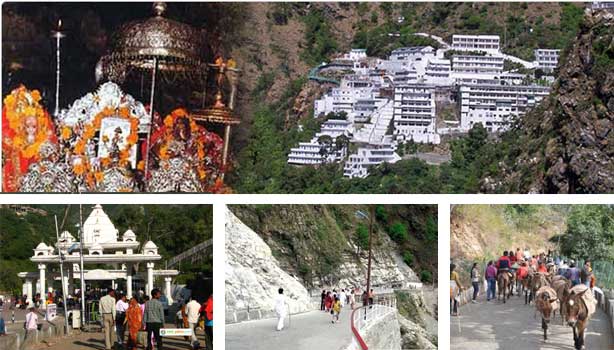The yatra to Mata Vaishno Devi shrine is one of the holiest and the most arduous pilgrimages for Hindus all over the world. The shrine is at an altitude of 5,300 feet and is about 14 kilometres from Katra. The trek is not an easy one as the hills are steep and requires a lot of stamina and fitness. Instilled with a belief that Mata Vaishno Devi grants wishes to those who seek her blessings, from newlyweds to old couples, everyone undertakes this yatra.
Over the years, the facilities along the route to the holy shrine have made the journey comfortable. For the elderly and those of ill health, mule and pony rides are available to negotiate the steep incline. Furthermore, pilgrims can also avail helicopter services from Katra and Jammu to Sanjichat. Sanjichat is the highest point on the trekking route of Vaishno Devi. The Bhawan is a downhill trek of about 2.5 km from Sanjichat. Pure vegetarian food stalls and hygienic outlets are available at regular intervals so the pilgrims do not face any hassle during their journey.
The yatra and the route remain open for the pilgrims throughout the year. The most popular time to undertake the darshan is during the festive and auspicious time of the Navratras.
There are two routes you can take from Katra to get to the Bhawan - the old route and the new route. The old route is longer and considerably steeper. It goes through Ardha Kuwari, reaches the summit at Bhairav Ghati and from there climbs down to Bhawan. You can hire horses and ponies to reach Bhawan through the old route.
The new route is shorter and much easier to tackle. Although it does not go through Ardha Kuwari, many pilgrims first go to Ardha Kuwari, then get back to the base camp and then take the new route to the Bhawan. The new route does not go through Bhairav Ghati and horses and ponies are not allowed on this route. There are bhojanalyas and coffee shops at regular intervals of one kilometer on the new route.
Things to Do in Vaishno Devi
Deva Mai Temple
Located three miles short of Katra, the Deva Mai Temple holds special significance as a holy site in the hearts of the devotees. Pilgrims from all over the country visit this temple to perform religious rites and rituals.
Holy Cave of Shiv Khori
For most of the pilgrims, the pilgrimage to Vaishno Devi ends only when they’ve had a darshan of the holy cave of Shiv Khori. The cave is nearly 200 meters long and draws a large number of devotees to its four feet high naturally formed Shiva lingam.
Shrine of Dera Baba Banda
At a distance of 30 kilometres from Katra, the shrine of Dera Baba Banda is an epitome of religious harmony and is a major Hindu-Sikh pilgrimage center.
Raghunath Mandir
Situated on the bank of the winding Tawi River, in the heart of Jammu city, the Raghunath Mandir stands as a symbol of devotion coupled with opulence. Dedicated to Lord Rama, the temple’s gold plated interiors and artistic beauty cast a spell on the devotees.
Temple of Baba Dhansar
The Temple of Baba Dhansar, located at a distance of 15 kilometres from Katra, is dedicated to Lord Shiva. From between the rocks in a thick grove of trees, a huge spring emerges and flows into the sacred rivulet that eventually merges with the Chenab River.
Best Time to Visit Vaishno Devi
Peak Season
Vaishno Devi is open for pilgrims throughout the year, but the best time to undertake the journey is between the months of March and October. A lot of pilgrims visit Vaishno Devi between these months as the weather is cool and pleasant, but maximum visitors plan their trip during the Navratras.
Off Season
During the winters from November to February, the temperature reaches sub-zero levels and we recommend only the physically fit to visit at that time. The upside is that this is the time when the skies open up and Katra and the surrounding areas are cloaked in snow.
How To Reach Vaishno Devi
By Air
Located at a distance of 50 kilometres, the Jammu airport is the nearest to Katra. Jammu is well-connected with major airports in India. It’s easy to get a cab from the Jammu airport to Katra as regular taxi and cab services are available.
By Bus
Jammu and Kashmir State Road Transport Corporation buses operate to and from Jammu to Katra at regular intervals. Air-conditioned private deluxe buses and taxis are also available from Jammu to Katra.
By Train
The nearest railway station from Katra is the Udhampur railway station. Taxi and cab services are available from the railway station to Katra.
For the ease of Journey the tourist must:
- Register themselves at the booking counter Katra and get the yatra slip
- Get permission for the video camera, if interested.
- Check the identity card of the Pithoo, Pony and Palki before hiring them.
- For ease of Journey Travel as light as possible, since all the facilities are available on the track.
- Avoid the use of Polythene bag to protect the environment.
- Throw the waste in the waste-boxes available.
- Walk on the track only and enjoy the beauty of the nature. Wrong track can lead to disastrous results.
- While leaving for the Darshan of the Holy Shrine, deposit your belongings at the clock rooms and get the receipt.
- Donations are to be made at the donation counters and get the receipt duly signed.


